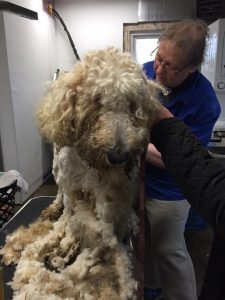What is a puppy mill?
All photos featured are of dogs we have rescued.
“Probably the most basic definition is that a puppy mill is any large-scale breeder who uses irresponsible breeding practices with the goal of making the most money possible in the shortest period of time. Smaller-scale breeders who are irresponsible are usually referred to as backyard breeders, although the problems are the same regardless of the size of the operation.
Irresponsible breeders are not concerned with the health of the puppies they sell. They don’t usually keep good records of which puppies came from which parents, and they don’t selectively breed out undesirable traits. The puppies are often weaned too early, creating nutritional and immune system deficits.
 Conditions at a puppy mill are usually far less than ideal. Overcrowded cages are not cleaned regularly, and veterinary care is scarce to non-existent.
Conditions at a puppy mill are usually far less than ideal. Overcrowded cages are not cleaned regularly, and veterinary care is scarce to non-existent.
Females in puppy mills are bred every time they come into heat, and when they cannot serve as incubators, they are killed to make way for dogs that can. As a dog is repetitively bred, she produces smaller and smaller litters until she is taken “out of service” due to the reduction in her productivity and profitability.
If the last paragraph sounds to you like something that would be said of a machine, congratulations. You have taken the first step in helping to eliminate puppy mills.” (Doggies.com, 2018)
What are the conditions like?
“In puppy mills, dogs are typically kept in small wire hutches inside sheds with no temperature control or outdoors with insufficient protection from harsh natural elements. They are exposed to extreme heat and cold as well as dangerously high levels of ammonia that arises from urine build-up. Uric acid soaks puppies lying on cage floors, burns their skin and paw pads, and causes respiratory distress.

The wire cage floors are meant to allow feces to drop through, but when cages are stacked, it falls onto the animals below. Feces often cakes cages so
heavily it becomes the only solid surface on which they can stand. This is completely at odds with a dog’s natural instinct to live separately from their excrement but they desperately long to feel the security of solid ground beneath their feet. Dogs in puppy mills are rarely, if ever, released from their cages to exercise or play.
Their imprisonment in cramped cages also causes the urine and feces buildup to severely mat the dogs’ fur. Frequently in a rescue situation, dogs are found so matted that their entire coat must be shaved off. Once shaved, dogs that had first appeared much larger are often revealed to be emaciated. In some cases, their matting and confinement are so extreme that their fur actually grows into the cage, pinning the dog in one spot.
Overgrown nails are extremely common in puppy mills and can actually get caught in or grow around the wire and trap a dog to the cage. Nails that are never trimmed or never worn down by walking or running on solid ground often grow back into the skin. This creates an infection that leads to painful suffering and life-threatening medical conditions. It is not unusual to find small collars that have not been changed as dogs have grown or collars that have been fastened so tightly that they have become embedded in a dog’s neck and must be carefully cut out.

Fighting is not uncommon in the overcrowded pens, which are too small for even one dog to be in even part of the day, much less their entire lives. The dogs spend most of their time unattended so fighting goes unnoticed and injuries are untreated. It is not abnormal to find dead dogs on a regular basis at a puppy mill. Some dogs endure a process called “de-barking” – having portions their vocal chords painfully removed to reduce the noise of their incessant pleas for help and attention.
Dogs also endure injuries from their dilapidated enclosures. Unsanitary living conditions attract bugs and rodents and breed infectious disease. The sick and injured dogs are rarely, if ever, seen by a veterinarian so their conditions result in endless suffering and sometimes death. The health of a puppy mill dog is not even sustained by adequate food and water. If there is water at all, it is typically filthy and contaminated with algae growth, urine, and feces. Any food present is often infested with maggots and mold.
Some puppy mills keep dogs in windowless breeding boxes, which are typically smaller than the main cages. Here, mother dogs give birth and live with their puppies through the weaning process, which is usually prematurely forced while the puppies should still be drinking their mother’s milk. This early weaning causes emotional trauma to both the mother dog and the puppies as well as health problems in the puppies.
Females are bred repeatedly, usually twice a year, every year, until they can no longer produce puppies. This is incredibly stressful on their bodies but they are viewed as moneymaking machines, as disposable property, not as individuals with inherent worth. Female dogs are commonly bred before it is safe to do so because the earlier they start, the more puppies they will produce in a lifetime. Puppy mill breeding dogs are often given hormones and steroids to try and increase the number of puppies they produce. These drugs can cause extreme pain and serious side effects – all in an attempt to increase the number of puppies for profit.” (Animalrescuecorps.org, 2018)
How are puppy mills legal?!
 “The most surprising thing to many people is that puppy mills are legal.
“The most surprising thing to many people is that puppy mills are legal.
The standards governing the care of dogs and cats in commercial breeding facilities are set forth in the federal Animal Welfare Act (AWA). The United States Department of Agriculture (USDA) is the agency responsible for overseeing the commercial dog breeding industry and enforcing the AWA. Any breeder who wishes to sell to a pet store or to consumers over the Internet with five or more breeding females must be licensed with the USDA.
There are two primary reasons why the AWA and USDA are not sufficient to protect dogs in commercial-breeding facilities:
• the AWA’s standards are too minimal to ensure humane care and treatment, and
• the USDA does not effectively enforce the AWA.
Even if enforced to its fullest extent, the AWA only requires the bare minimum in housing facilities and care. These standards are far below what most would consider humane, or even acceptable. The AWA also leaves significant discretion in the hands of puppy mill owners to decide what constitutes an adequate level of care for the dogs with respect to living environment, cleanliness and sanitation, feeding, veterinary care, housing structures, and comfort.
What is allowed under the AWA?
• There is no limit to the number of dogs on the premises. A puppy mill could have hundreds or thousands of dogs.
• There is no requirement on the number of staff that must be available to care for the dogs.
• Dogs may be kept in stacked cages.
• Mesh or wire flooring is allowed.
• Dogs may be forced to relieve themselves in their cages.
• Dogs may be confined in spaces only six inches larger than their bodies, not including the tail.
• A dog may be caged 24 hours a day for his or her entire life, only removed from the cage to be bred.
• There is no exercise requirement if dogs are housed with other dogs and certain minimal size requirements are met for the dog’s enclosure.
• Human interaction is not required.
• Breeding females at the first heat cycle and every heat cycle is permissible.
• Unwanted animals may be killed or auctioned off.
• Many of the AWA’s requirements are vague. The AWA leaves it up to the mill owners to determine what is “adequate”.
What’s wrong with USDA enforcement?
The USDA is overburdened.
• The USDA currently has an estimated 110 inspectors on staff to inspect all the facilities under its supervision, not just commercial dog breeders and brokers. In 2010, these inspectors were responsible for 8,782 facilities.*
• The division of the USDA that is responsible for inspecting commercial dog breeding facilities is also responsible for animal exhibitors (circuses, zoos, petting farms, wildlife parks), research facilities (hospitals, universities, pharmaceutical firms), and animal transporters (airlines and trucking companies).
• Inspections are often infrequent. After the initial inspection for a new licensee, inspections are based on “Risk Based Inspection System”.
• This system means that facilities determined to be lower risk may only be inspected once very 2-3 years. Moderate risk facilities may only be inspected once a year.
*TPMP submitted a FOIA request to the USDA in July, 2014, requesting the number of inspectors and the number of facilities under their purview, but despite our repeated attempts, the USDA has failed to respond to our original FOIA request or follow up requests.
USDA inspectors have a record of leniency towards commercial breeders.
• When audited, the auditors found that many inspectors took little or no action against most violators of the AWA, including many which had repeat violations.
• It also found that USDA did not properly cite or document violations, or report repeat and direct violations, leading to less frequent inspections and leaving the animals at a higher risk for neglect and illness.
• For example, some serious direct violations were incorrectly reported as indirect violations. This included conditions such as significant tick infestations on the dogs, cockroach-infested food sources, and excessive accumulations of feces and waste.
• The audit also found that the USDA misused its guidelines to lower the penalties for violations, miscounted violations, and changed the gravity of violations.” (Thepuppymillproject.org, 2018)
Animalrescuecorps.org. (2018). Puppy Mills | Animal Rescue Corps. [online] Available at: http://animalrescuecorps.org/learn/puppy-mills/ [Accessed 9 Jul. 2018]. Doggies.com. (2018). Puppy Mills: Why and How to Avoid Them. [online] Available at: http://www.doggies.com/articles/88-puppy-mills-why-and-how-to-avoid-them.html [Accessed 9 Jul. 2018]. Thepuppymillproject.org. (2018). The Puppy Mill Project – Puppy Mills and the Law. [online] Available at: http://www.thepuppymillproject.org/relevant-laws/ [Accessed 9 Jul. 2018].